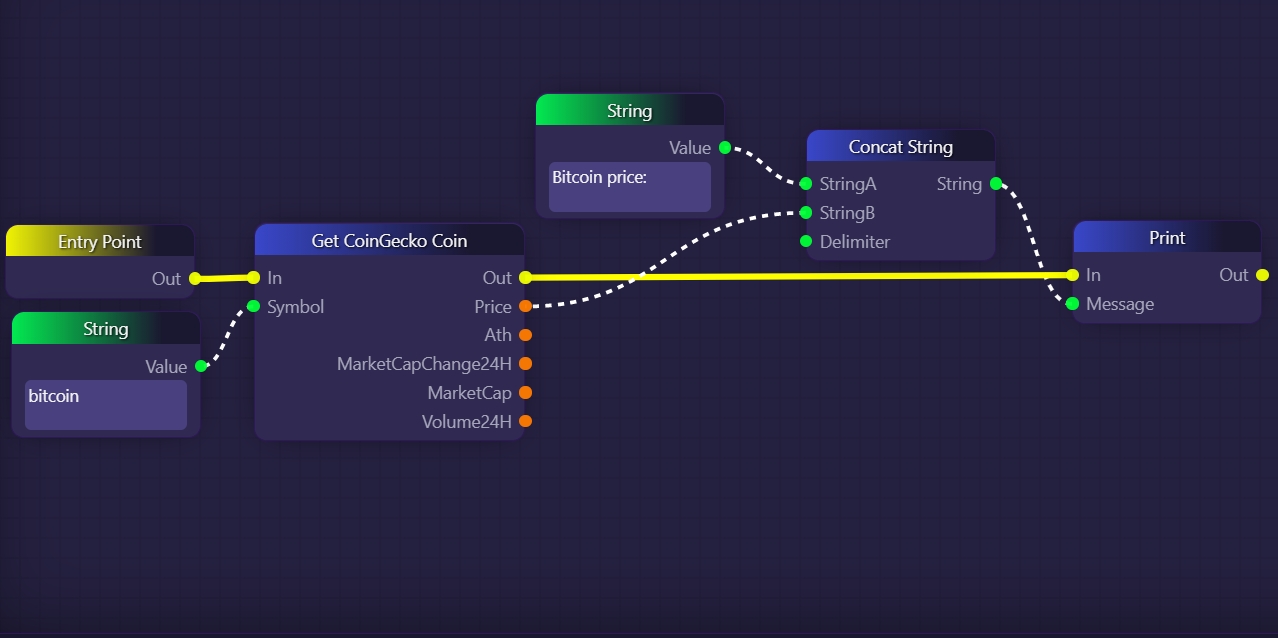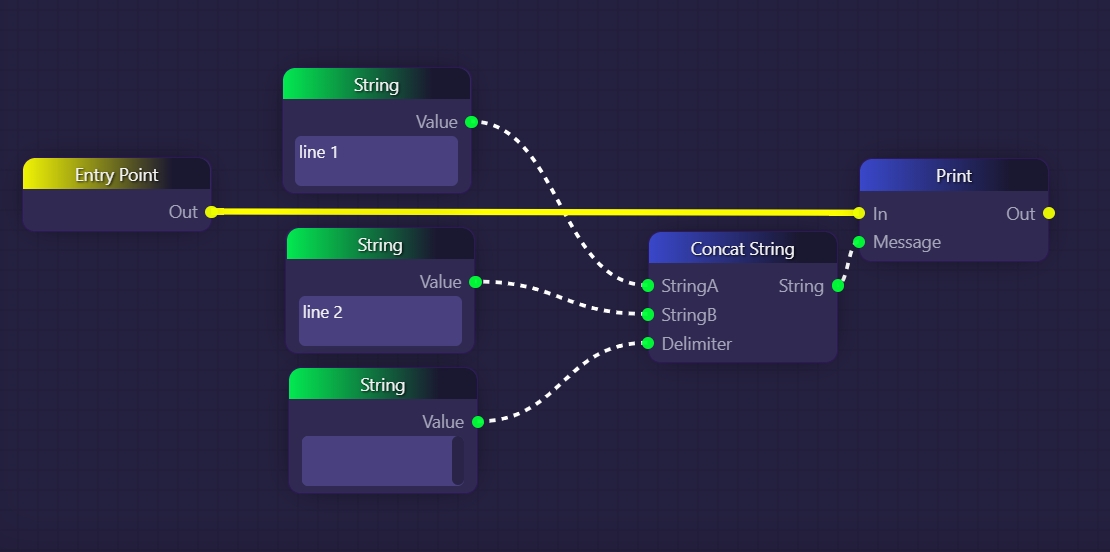Concat String
Concatenation is the operation of joining character strings end-to-end
The Concat String block in the GraphLinq IDE is a versatile tool that allows developers to merge two strings into a single string. This block is invaluable for building dynamic and informative messages by combining multiple text elements within graphs. It provides essential functionalities for string manipulation and data presentation.
Block Description
The Concatenate String block is part of the String category in the GraphLinq IDE. Its primary function is to merge two input strings into a single output string.
Input Parameters
The Concatenate String block requires two input parameters:
String A (String Type): This parameter represents the first string that will be included in the output. It could be a fixed string or a string variable obtained from other blocks.
String B (String Type): The String B input is the second string that will be concatenated with String A to form the final output string.
Output
The output of the Concatenate String block is a single string that results from merging String A and String B together. The output string is a combination of the text from both input strings.
Example Use Case
Let's explore a practical example to illustrate how the Concatenate String block can be used in a graph:
The graph contains a variable "userName" that stores a user's name obtained from external sources.
The String block is used to create a fixed text, such as "Welcome, ".
The Concatenate String block is then employed to combine the fixed text with the value of the "userName" variable.
The final output from the Concatenate String block will be a personalized greeting message, such as "Welcome, John!" or "Welcome, Jane!" depending on the value stored in the "userName" variable.
In this example, the Concatenate String block allows the graph to create dynamic and personalized messages by merging fixed text with variable data. This enables developers to build more engaging and interactive applications that can provide personalized feedback and responses.
The Concatenate String block is a crucial element in the GraphLinq IDE for working with textual data within graphs. Its ability to combine two strings into a single output string provides valuable functionalities for generating personalized messages and dynamic content. By utilizing the Concatenate String block, developers can enhance the user experience by delivering customized responses and informative messages, making their applications more user-friendly and interactive.
More Information
The Concatenate String block, often referred to as "Concat String," is a fundamental component in the GraphLinq IDE for working with strings. As the name suggests, this block is used to concatenate or combine multiple strings into a single string.
Usage
The Concatenate String block takes two strings as inputs and merges them together to form a new string. The output of this block is the result of combining the input strings. It provides a simple yet powerful way to create dynamic messages, generate meaningful information, or construct complex text outputs in graphs.
Example
Let's consider a practical example where we have two strings, "Hello" and "World." By using the "Concatenate String" block, we can merge these two strings into a single greeting message, such as "Hello World." The block takes "Hello" as one input and "World" as another, and the output will be the concatenated string "Hello World."
Advantages
The Concatenate String block allows developers to dynamically build strings based on various inputs, making it ideal for generating customized messages and responses within graphs. It enhances the flexibility and versatility of graph designs by enabling the creation of dynamic content based on real-time data or user interactions.
Summary
The Concatenate String block in the GraphLinq IDE is a powerful tool for merging multiple strings into a single coherent string. It is widely used for creating dynamic messages, generating informative outputs, and building flexible applications that respond to different scenarios with customized text. With the ability to combine strings easily, developers can craft engaging and interactive experiences within their graphs.
Full Example
Concat String blocks are used to combine two strings into one string. They take three strings as input: the two strings you want to merge together, and a delimiter string. When a Concat String block executes, it will stick the second string onto the end of the first string, with the delimiter string inserted between them. If you don't provide a delimiter, then it will default to a space character.

In the above example, we are looking up the price of Bitcoin on CoinGecko. Then, we are using a Concat String block to combine the string "Bitcoin price:" with whatever price is output by the Get CoinGecko Coin block. The resulting concatenated string is then passed to the Print block as a single string, where it is printed to the logs looking something like:
Note that in the above example, we didn't pass anything as the third "Delimiter" input of the Concat String block. Therefore, the default space character was used, which is why there is a space between the: and the 3.
If instead, we attach a String block as the delimiter of the Concat String, but then leave the string empty, then no delimiter will be used, and our two strings will be merged directly together with nothing between them, like in the following example:

It is also possible to insert a line break between our strings by pressing enter after clicking in the String block like so:


Last updated
